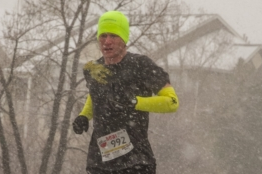This past weekend I ran a time trial. When I was accepted onto the 2020 Runners Roost Race Team #roostraceteam, I had a set of goals and was looking forward to training for them. Obviously things changed in March with races being cancelled or going to virtual formats. Luckily, I’ve had the opportunity to do some time trials with a couple of friends. The first one was a little over a month ago, a 5000M on the track. This past weekend, we met to do two, one-mile time trials. The course was a downhill mile that is traditionally run on July 4th. We decided to race it uphill first and then do the downhill, with roughly fifteen to twenty minutes of rest and jogging in-between. Equipped with watches and sidewalk chalk, we marked the course, took our marks, and set off.
Often having someone to race “with” can help push you and since the fastest among us was always out in front and on his own, before the downhill mile I suggested that we stagger our start so that we all would have someone to focus on catching during the race. We kept the start delay to ten seconds between each of us which allowed them to each catch at least me (they’re both faster), but they would likely pass me before the end so that I would then also have someone to try and catch. It added an extra level of interest to the race and basically worked the way we wanted.
Mile races, whether formal or as a time trial, are tough. About 100M into the uphill mile, my brain was moving in a thousand directions, mostly on variants of the question, “What have I done?” For the downhill mile, I never assumed it would be easy but I also didn’t appreciate how much of an effort it would be. Before we started, as we were running down the hill so we could set up for the uphill mile start, they pointed out spots along the course where, during the race, certain thoughts creep up including, “What have I done?” This proved to be very helpful for even though the experience was new for me, I had the same thoughts at the same spots and realized they weren’t unique.
My expectations were matched in my downhill mile time. According to one of my friend’s Strava, you could add twenty seconds to your time to get a somewhat accurate flat mile estimate. I posted a 5:17 and so this would translate to 5:37. When I was first considering training for the mile, I figured that somewhere in the high 5:30s was about as fast as I could be without focusing on speed. So, assuming the plus-twenty is accurate then I am about where I figured I could be without extensive speed training. In theory, more speed training would make me faster and I should lower my time. (It also reinforces that the 5:10 I posted in late March was probably due to the course that I ran being a little short. Oh, well.)
Running is one sport that may be able to come back as an event for amateur competitors sooner than others because it’s easier to social distance. Yet, it’s difficult to imagine large races coming back any sooner than next spring, or to have substantial demand for them if they do. In the meantime, time trials with a couple of friends are a good way to keep sharp.

Running anecdotes, running food reviews, some race coverage, and more